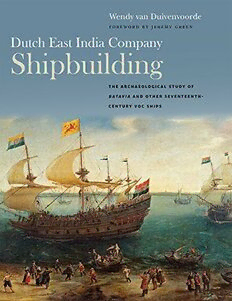
Dutch East India Company Shipbuilding: The Archaeological Study of Batavia and Other Seventeenth-Century VOC Ships PDF
Preview Dutch East India Company Shipbuilding: The Archaeological Study of Batavia and Other Seventeenth-Century VOC Ships
ed rachal foundation nautical archaeology series In association with the Institute of Nautical Archaeology and the Center for Maritime Archaeology and Conservation Dutch East India Company Shipbuilding - Wendy van Duivenvoorde foreword by jeremy green texas a&m university press College Station Copyright © 2015 by Wendy van Duivenvoorde Manufactured in the United States of America All rights reserved First edition Th is paper meets the requirements of ansi/niso z39.48-1992 (Permanence of Paper). Binding materials have been chosen for durability. o Library of Congress Cataloging- in-Publication Data Van Duivenvoorde, Wendy, 1974–, author. Dutch East India Company shipbuilding: the archaeological study of Batavia and other seventeenth-century VOC ships / Wendy van Duivenvoorde; foreword by Jeremy Green.—First edition. pages cm—(Ed Rachal Foundation nautical archaeology series) Includes bibliographical references and index. isbn 978-1-62349-179-6 (printed case: alk. paper)—isbn 978-1-62349-231-1 (ebook) 1. Batavia (Ship) 2. Nederlandsche Oost-Indische Compagnie—History. 3. Indiamen—Netherlands. 4. Shipbuilding— Netherlands—History—17th century. 5. Hulls (Naval architecture)—Design and construction. 6. Shipwrecks—Australia—Western Australia. 7. Underwater archaeology—Australia—Western Australia. I. Title. II. Series: Ed Rachal Foundation nautical archaeological series. vm393.i64v36 2015 623.82209492(cid:2)09032—dc23 2014019853 To my parents, Jacobus Johannes van Duivenvoorde and Anna Klazina Maria van Duivenvoorde- Knopjes Foreword, by Jeremy Green ix Acknowledgments xi Legend for Timber Drawings xiii 1 Introduction 1 2 From Carvel Construction to VOC Shipbuilding 8 3 Site Formation, Excavation, and Reconstruction 40 4 Hull Study and Description 73 5 Th e Archaeology of Dutch Oceangoing Ships 143 6 Double- Hull Planking and Sheathing 186 7 Timber Used in the Construction of Batavia 206 8 Analysis of Batavia’s Hull and Construction 224 9 Conclusion 235 Appendix A: VOC Ship Construction Charters 241 Appendix B: Catalog of Batavia Hull Remains 253 Appendix C: Terminology for Dendrochronological Research, by Elsemieke Hanraets 265 Notes 267 Bibliography 291 Index 303 It is with great pleasure that I write the foreword for this book. Having spent most of the 1970s excavating and researching the Batavia shipwreck, and then fi nally overseeing reconstruction of the recovered surviving portion of the ship’s hull aft er a lengthy con- servation process, I was aware that the details of hull construction had not been properly documented. At the Fift h International Symposium on Boat and Ship Archaeology in Amsterdam in 1988, I presented a paper on the planking-fi rst construction of Batavia’s hull. Th is came as a bit of a shock to many of the conference participants, as it was generally accepted that planking-fi rst, or shell-fi rst, construction had died out by the seventeenth century. At that time, few seventeenth- century ships had been excavated archaeologically, and no other hull structure from a Verenigde Oostindische Compagnie (VOC) ship had been excavated. Subsequent examination of contemporary paintings and illustrations revealed that this system was widely used, at least in the Netherlands, and particularly by the VOC. However, the thought of documenting the Batavia hull in great detail was for me quite daunting. What I needed was a researcher well versed in nautical archaeology and wooden ship construction who was also capable of studying Dutch archival material. In June 2002, I ran into Wendy van Duivenvoorde at the Bodrum airport in Turkey. We were both on our way to the International Symposium and Workshop on Underwater Archaeology, hosted by Turkey’s Ministry of Culture and the Institute of Nautical Archae- ology (INA) in Bodrum and at nearby Pabuç Burnu. Wendy and I had worked together the previous summer at Tektaş Burnu, Turkey, on the fi nal season of INA’s Classical shipwreck excavation and later in Galle, Sri Lanka, on the VOC Avondster project. Our concurrent arrival in Bodrum, from opposite sides of the world, was truly serendipitous, and I was not about to waste this opportune encounter. As we walked together through the airport lobby, chatting casually and catching up on what we had been up to since we last saw each other, I asked Wendy about her long- term plans. When she replied that she was somewhat frustrated in fi nding a ship-r elated research project, I wasted no time in making a pitch. Here was a Dutch maritime archaeologist eager for a research project, and I had just the thing. We were still making our way through customs when I told her of the Batavia hull remains that needed studying, as well as related materials from three other VOC shipwrecks in the Western Australian (WA) Museum. I off ered her not only the material for study but also a position at the museum. We collected our luggage and headed off to the conference, all the while discussing possible research plans, specifi cs about the archaeological material, living in Fremantle, and sundry other matters. Upon her return to Texas A&M University in College Station, Texas, Wendy developed and submitted a formal research proposal for the project. Aft er receiving approval, she spent the following two years conducting historical and archival research but also visited the museum on two occasions to begin the recording and sampling program. In 2006, Wendy fi nally relocated to Fremantle and started work as an assistant curator in the WA Museum’s Department of Maritime Archaeology. It took another two years and count- ix
